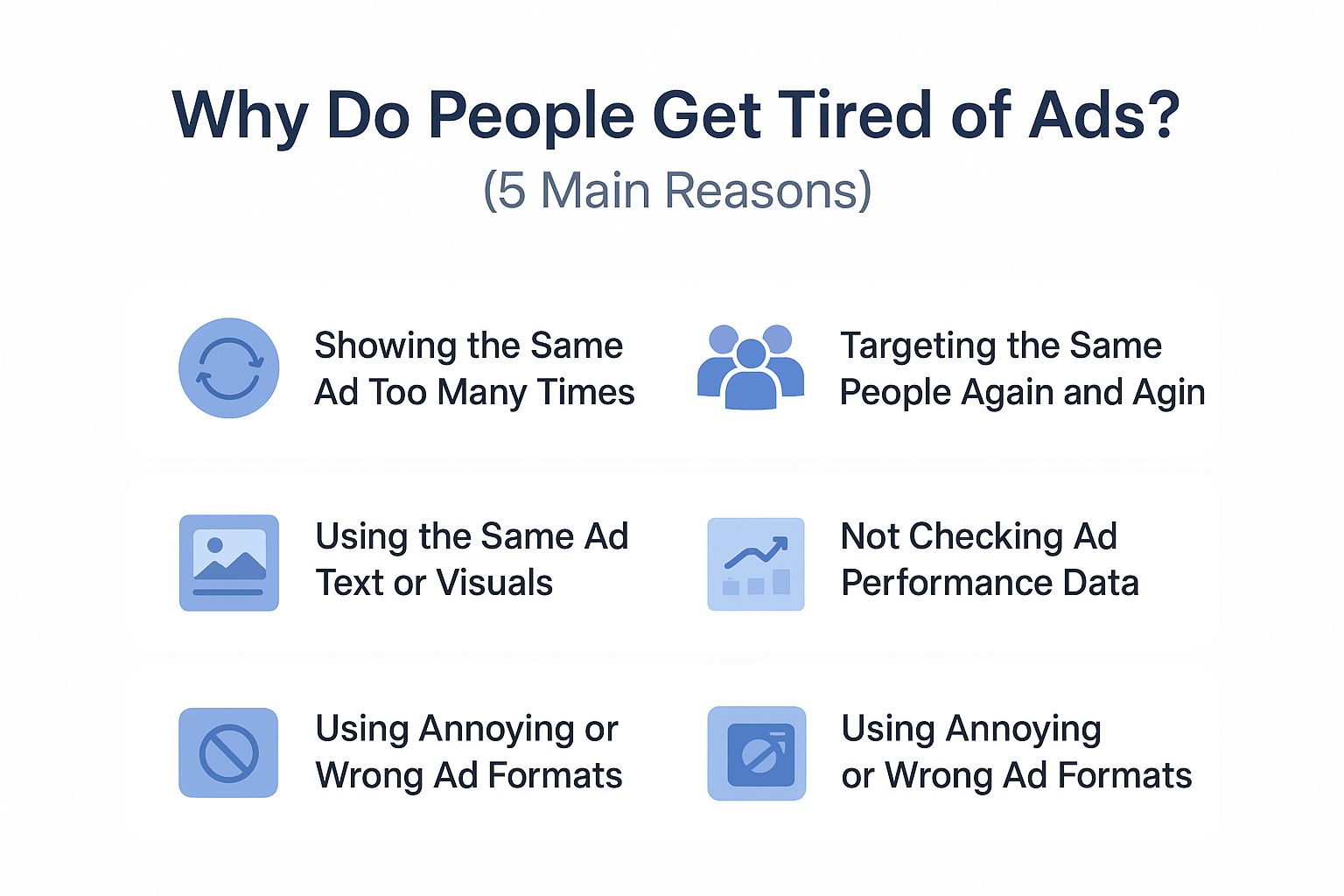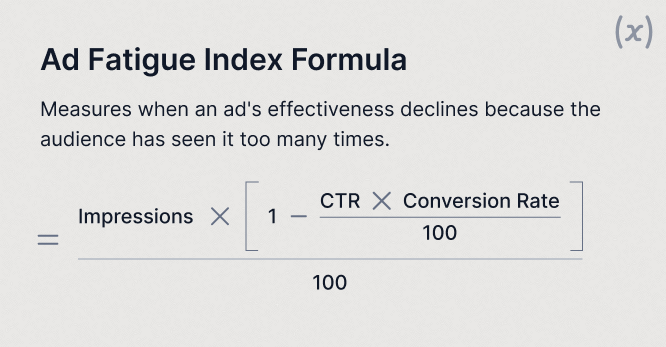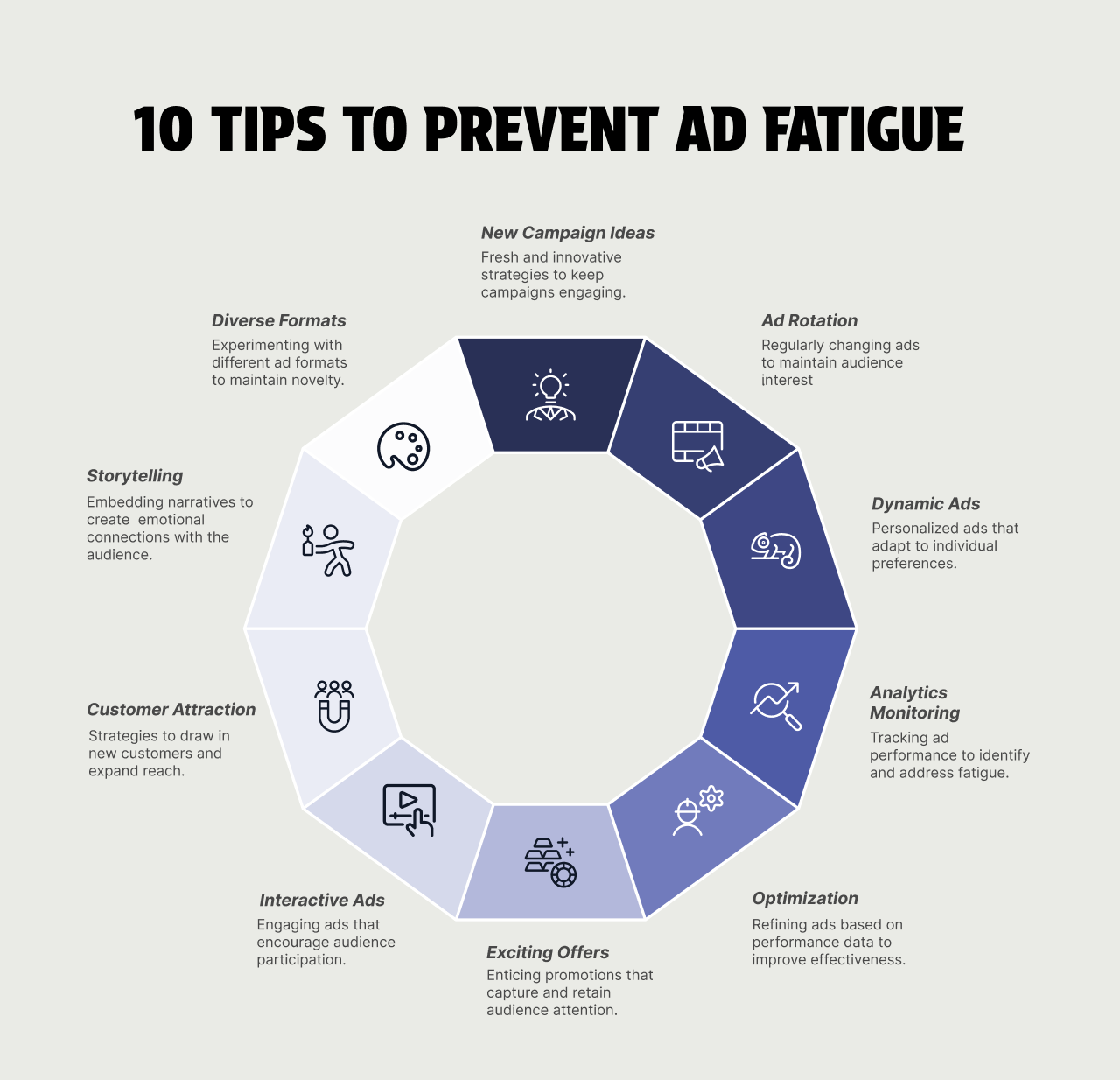In the times of digital media, users see hundreds of ads in a day, mostly unconsciously. Hardly a few of them make an impact or register in the user's mind.
But You know what, there are some great tips to prevent ad fatigue, but first let’s understand what is ad fatigue and how it impacts businesses.
What is Ad Fatigue and Why It Matters
Ad fatigue is the experience users feel when they are repeatedly bombarded with the same ad. It’s a phenomenon in which customers feel bored and disengaged and scroll up the ad in just a second.
This can harm your brand's engagement, click-through rates, and conversions and reduce a campaign's overall effectiveness. It is indeed real and bothersome for many brands.
Why Do People Get Tired of Ads? (5 Main Reasons)

1. Showing the Same Ad Too Many Times
Ad platforms like Google and Facebook often prioritize displaying high-performing ads repeatedly. This can lead to complete exhaustion and loss of interest in checking the ad anymore.
2. Targeting the Same People Again and Again
Targeting the same set of audiences now and then can cause audience burnout. There are higher chances of putting ad blockers, unfollowing your page, or muting posts. Lack of dynamic targeting and personalization is one of the huge reasons behind ad fatigue.
3. Using the Same Ad Text or Visuals Repeatedly
No matter how interesting your ad copies are, they are likely to lose their charm in a couple of days. With the excessive outburst of ads everywhere, users’ attention spans have significantly reduced. Using the same ad creatives, headlines, jingles, or CTAs can easily cause fatigue.
4. Not Checking Ad Performance Data
Brands that don’t monitor ad performance regularly are on the verge of becoming irrelevant. Ignoring key metrics such as clicks, impressions, CTR, engagement rate, and conversion rate can be the reason behind customers' high ad weariness.
5. Using Annoying or Wrong Ad Formats
Pushing invasive and irrelevant pop-ups, overlays, and auto-playing advertisements are examples of ad forms that disrupt the user experience and can irritate viewers and hasten fatigue.
Now Question comes in, Is there a way to calculate ad fatigue? - The Answer is Yes!
Ad Fatigue Index Formula
Ad Fatigue Index (AFI) helps advertisers in determining when overexposure is beginning to reduce the impact of their ads. Although the Ad Fatigue Index doesn't have a standard formula, marketers frequently use metrics such as ad quality, audience demographics, frequency, impressions, and targeting accuracy to calculate ad fatigue for their campaigns.

A higher Ad Fatigue Index indicates a higher likelihood of ad fatigue. A lower AFI suggests that the ad is still doing well and successfully interacting with the audience.
How to Know If Your Ads Are Losing Impact (5 Signs)
1. Ad Costs Go Up (CPC & CPM)
CPC (Cost per click) and CMP (Cost per Mile) are two important metrics to track the cost of clicks and impressions of the ad. When your ad is not getting enough engagement, ad platforms charge more to get reach.
2. Fewer Clicks and Falling CTR
The ad can get impressions, but the number of clicks will be lower quite significantly. As the number of clicks decreases, the CTR (click-through rate) also falls. If you see a decline in the CTR percentage, it is an alarming sign to try something new.
3. Conversions Drop
When a brand experiences ad fatigue, its sales and lead generation suffer. This signals that the ad is no longer resonating with the audience; it has become stale and unimpressive. Tweaking the ad with a new offer can be a way to engage them again.
4. Ad Frequency is Too High
Ad platforms like Google and Facebook offer frequency scores, where you can check the minimum number of times a specific user sees your advertisement in a specified amount of time. To prevent ad fatigue, the ad should be shown a maximum of 3-5 times per week.
5. Less Engagement on Ads
If you’re catering to the audience through Facebook, you can check the ad engagement rate in the form of likes, comments, shares, and views, which can tell how they perceive the ad and how likely it is to go under fatigue.
10 Practical Tips to Stop Ad Fatigue

It is a serious issue faced by advertisers. Knowing ways to prevent ad fatigue among customers can be a turning point for your brand. Here are some of the practical ways to combat and tiredness:
1. Bring Fresh Campaign Ideas
Experiment with new ad ideas or utilize viral marketing. Nobody likes to watch or read things repeatedly; they seek to see new ideas, multiple variations, and some change after a few days. Bring new campaigns for different products or services frequently to reduce the feeling of fatigue among viewers.
Check these highly engaging 8 Brilliant Interactive Ad Examples
2. Rotate Ads Regularly
It’s a good practice to rotate ad visuals in different variations from time to time. Furthermore, test different audience segments using demographics, interests, and behaviors in the cycle to make a single ad continuously. This keeps the audience interested by preventing them from seeing the same ad repeatedly.
3. Use Personalized and Dynamic Ads
The growing use of personalization has proved to be one of the best ways to avoid ad fatigue. Dynamic ad copies and personalized messaging can help customize the ad experience according to the user’s preferences.
4. Keep Tracking Ad Performance
Monitor key performance indicators such as engagement metrics, conversion rates, and click-through rates (CTR) every week. A drop could indicate that your ads are getting little to no engagement. Mark and set alerts when the metrics reach the fatigue threshold. This can help optimize or introduce changes to the campaign at the right time.
5. Optimize Ads with A/B Testing & Frequency Caps
Optimizing Google and social media ads is essential for improved ad effectiveness. The most effective practices to follow to reduce ad fatigue include frequency capping, A/B testing, and audience optimization.
By following these optimization techniques, you can easily reduce ad tiredness: By setting a frequency cap, overexposure can be prevented.
- Run A/B tests to find out which versions of your ads perform better.
- Remove the non-engaging audience from the audience segment.
6. Engage with Offers and Discounts
Providing customers with exciting offers, discounts, and sales can engage users. Appealing to them to act using CTA buttons will reduce the ad fatigue rate. Using retargeting with some deals that entice them to buy can be a good strategy for the overall campaign.
7. Make Ads Interactive and Fun
It’s the right time for advertisers to leap towards digital and interactive forms of advertising from traditional ones. Adding interactivity to the ads in terms of shoppable ads, quizzes, polls, fun games, and more can be a transformative move in preventing ad fatigue.
Click here to see Best Interactive Ads Examples
8. Reach New Customers with Fresh Campaigns
Broaden your customer base with new campaigns, product launches, and discount offers. Experiment with some innovative campaign ideas such as seasonal specials or limited-time deals to generate interest and a sense of urgency. Launch new products catering to a certain audience demographic.
9. Tell Stories Through Ads
Storytelling is a process used by product marketers to transmit a message to their audience, via the blend of information and story. The idea is to make the users encourage them to take action and to strengthen their brand loyalty.
10. Test Different Ad Formats (Video, Carousel, etc.)
Try utilizing multiple ad formats where the target audience is likely to be present, including the carousel, video, text, or display ads. New ad formats and platforms can help break the monotony and more successfully capture attention.
How KappaX Helps Brands Avoid Ad Fatigue
As mentioned, adding creativity and interactivity to the ads can help minimize ad fatigue in the customers. We build an interactive and delightful no-code editor ad experience that supports real-time customization. The ads encourage engagement and actions based on the customer’s preferences.
Adding interactivity to the ad has higher chances of conversion and fewer chances of tiredness.
Final Thoughts
Brand marketing is not just about generating sales; it’s more about how users perceive your brand. Do users have any impression of you as a brand? Do they easily recall the brand? How often do they like to engage with ads and posts?
The condition known as "ad fatigue" describes how an audience loses interest after seeing your ads too frequently. It’s time to acknowledge this and spice up your marketing game. The above-mentioned tips to prevent ad fatigue can really provide you great results.
